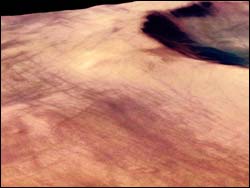Promethei Terra, southern highlands of Mars

Martian dunes
These images, taken by the High Resolution Stereo Camera (HRSC) on board ESA’s Mars Express spacecraft, show a part of the southern highlands of Mars, called Promethei Terra.
The images were taken during orbit 368 in May 2004 with a ground resolution of approximately 14 metres per pixel. The displayed region is centred around longitude 118° East and latitude 42° South.
They show an area in the Promethei Terra region, east of the Hellas Planitia impact basin. The smooth surface is caused by a layer of dust or volcanic ash that is up to several tens of metres thick.
This layer has covered all landforms, and even young impact craters have lost their contours due to in-fill and collapse of their fragile crater walls. This layer has been removed by the wind at some ridges and crater walls.
Although these images were taken at high resolution and show very fine detail, this covering layer leads to a slightly fuzzy appearance.
The large impact crater in the southern part of the image is 32 kilometres wide and up to 1200 metres deep. The dark crater floor is most likely the result of ‘deflation’, the geological term for the lifting and removal of loose material.
The dust removed here has accumulated in the southern part of the crater, forming a thick layer. The numerous dark tracks to the north-western and west are ‘dust devil’ tracks.
These atmospheric ‘eddies’, like tornadoes on Earth, remove the uppermost dust layers which have a slightly different colour to the now-exposed surface. The tracks can be more than 20 kilometres long and contrast prominently with the lighter-coloured surroundings.
Dust devil tracks provide short-lived evidence of the ongoing geological and atmospheric activity on Mars, which consists mainly of the transport of dust by wind.
Another sign for this ‘aeolian’ (wind-related) activity in the area is the existence of small dune fields that have formed in some of the depressions. They can be seen in the crater in the north and in its surroundings (see close-up).
The dust devils are not limited by geomorphological boundaries: for example, their tracks cross the crater rim. Dust devil tracks can also be seen on the thick dust layer in the southern part of the crater.
Due to the thickness of the dust layer, no darker material is exposed here. The dust devil tracks show two distinct directions of movement: east to west and south-east to north-west.
The colour images have been processed using the nadir (vertical view) and three colour channels, and the perspective views have been calculated from the digital terrain model derived from the stereo channels. The 3D anaglyph image has been created from the nadir and one stereo channel.
Media Contact
All latest news from the category: Physics and Astronomy
This area deals with the fundamental laws and building blocks of nature and how they interact, the properties and the behavior of matter, and research into space and time and their structures.
innovations-report provides in-depth reports and articles on subjects such as astrophysics, laser technologies, nuclear, quantum, particle and solid-state physics, nanotechnologies, planetary research and findings (Mars, Venus) and developments related to the Hubble Telescope.
Newest articles

Superradiant atoms could push the boundaries of how precisely time can be measured
Superradiant atoms can help us measure time more precisely than ever. In a new study, researchers from the University of Copenhagen present a new method for measuring the time interval,…

Ion thermoelectric conversion devices for near room temperature
The electrode sheet of the thermoelectric device consists of ionic hydrogel, which is sandwiched between the electrodes to form, and the Prussian blue on the electrode undergoes a redox reaction…

Zap Energy achieves 37-million-degree temperatures in a compact device
New publication reports record electron temperatures for a small-scale, sheared-flow-stabilized Z-pinch fusion device. In the nine decades since humans first produced fusion reactions, only a few fusion technologies have demonstrated…





















